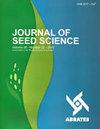鹰嘴豆种子活力评价电导率试验的调整
IF 1.2
4区 农林科学
Q3 AGRONOMY
引用次数: 1
摘要
摘要/ Abstract摘要:鹰嘴豆种子生理潜能评价方法的定义对于确保高产的商业化具有重要意义。因此,本研究旨在确定鹰嘴豆种子电导率试验的最适宜条件,并根据活力水平进行批次分类。因此,对5个品种BRS Aleppo和4个品种Cícero的种子进行了初步品质表征试验,并与电导率试验结果进行了比较。为了评估电导率,在25°C的温度下,将5个浸泡期(2、4、8、12和24小时)与4体积水(75、100、150和250 mL)相结合。结果表明,电导率试验能有效地评价鹰嘴豆种子的生理电位,提供的信息与其他活力试验相当。电导率测试,建议使用50粒种子,在150ml水中浸泡24 h,温度为25℃。本文章由计算机程序翻译,如有差异,请以英文原文为准。
Adjustment of the electrical conductivity test to evaluate the seed vigor of chickpea (Cicer arietinum L.)
Abstract: The definition of methodologies that allow evaluating the physiological potential of chickpea seeds is important to ensure the commercialization of lots with high performance. Thus, this research aimed to determine the most suitable conditions for conducting the electrical conductivity test in chickpea seeds to classify lots according to vigor level. Therefore, seeds from five lots of cultivar BRS Aleppo and four lots of cultivar Cícero were subjected to tests to characterize their initial quality and the results were compared with those obtained in the electrical conductivity test. To assess electrical conductivity, five soaking periods (2, 4, 8, 12, and 24 hours) were combined with four volumes of water (75, 100, 150, and 250 mL) at 25 °C temperature. The results show that the electrical conductivity test is efficient in evaluating the physiological potential of chickpea seeds, providing information equivalent to other vigor tests. For the electrical conductivity test, it is recommended to use 50 seeds soaked in 150 mL of water, for 24 h, at 25 °C.
求助全文
通过发布文献求助,成功后即可免费获取论文全文。
去求助
来源期刊

Journal of Seed Science
Agricultural and Biological Sciences-Agronomy and Crop Science
CiteScore
2.00
自引率
30.00%
发文量
28
审稿时长
12 weeks
期刊介绍:
From 2017 the Journal of Seed Science (JSS) will circulate online version only.
Original scientific studies and communications, not yet published or submitted to another journal for publication and written in Portuguese or English, will be accepted for publication. For manuscripts submitted in English, the authors should provide an adequated version.
The SCIENTIFIC COMMUNICATION is a category of scientific manuscript which describes a technique, an equipment, new species or observations and surveys of limited results. It has the same scientific rigor as the “Scientific Articles” and the same value as a publication. The classification of a manuscript as a SCIENTIFIC COMMUNICATION is based on its content and scientific merit but it can be a preliminary study, simple and not definitive on a certain subject, with publication justified by its uniqueness and contribution to the area.
The Editorial Board of the JSS may invite leading authors of recognized reputation to compose specific Review Articles covering topics of their specialization that will convey to the scientific community the state-of-the-art knowledge related to the specific theme.
 求助内容:
求助内容: 应助结果提醒方式:
应助结果提醒方式:


